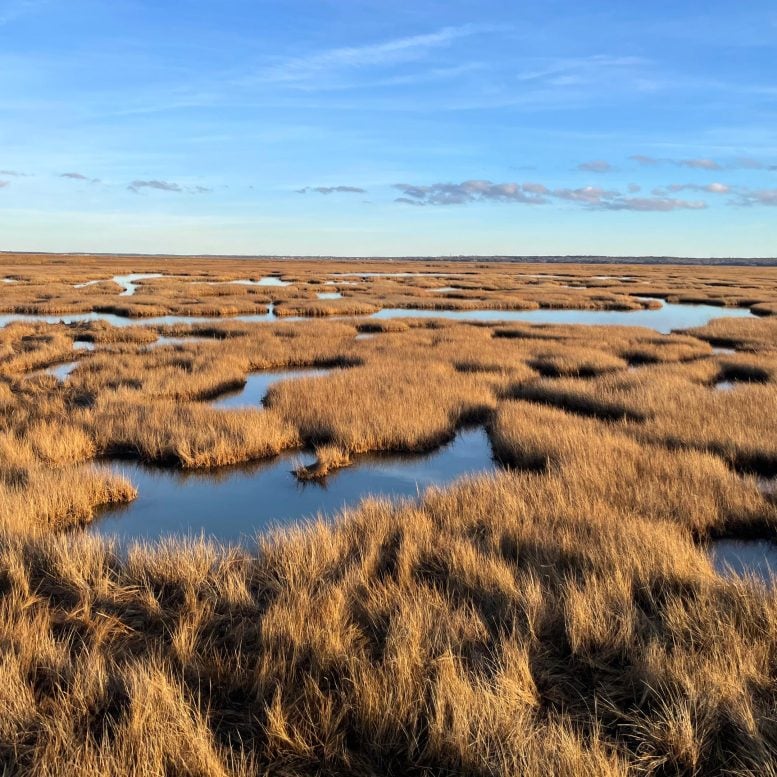The Inadequate Sediment Supply: Why Rivers are Ineffective in Saving Coastal Wetlands

An eroding and drowning salt marsh in Barnstable, Massachusetts, indicates the rising sea levels as of December 2, 2022. This image was captured by Erin Peck.
Finding ways to bolster wetlands succumbing to escalating ocean levels remains a challenging task, yet scientists seem to have moved one step closer towards finding solutions.
As climate change persists, extensive dam removal endeavors have been considered as a feasible solution to the gradual loss of coastal wetlands that lessen flooding, purify water, and serve as wildlife habitats. However, researchers in a recent publication in Science have found that this tactic is ineffective for most of the rivers in the U.S.
They explain that the crucial problem is the insufficiency of sediment. In the analysis of approximately 5,000 rivers, three out of every four were incapable of supplying adequate sediment to commensurate with the sea-level rise in linked coastal regions. Almost half were lacking the necessary sediment by a factor of at least ten.
This study is the first of its kind on a national level to look into how much sediment from watersheds rivers could deposit into coastal areas. Earlier research focused solely on a few significant rivers like the Mississippi and steep ones like the Elwha in Washington, which do not appropriately represent most others in the continuous United States.
The scientists noted that most U.S. watersheds are rather small and do not primarily contribute to sediment accumulation in wetlands. On these minor rivers are where the majority of dams are found.
Scott Ensign, a Research Scientist with Ph.D., from the Stroud Water Research Center, a global nonprofit dedicated to studying freshwater streams and rivers, spearheaded the research. He remarked that while the Elwha river stands as a prime example of a dam removal project revitalizing coastal sediment due to the significant sediment and sand release, it isn't reflective of other geographical areas.
He added that rivers on the East and Gulf coasts are less steep compared to those on the West Coast, and they have a lesser amount of sediment that could potentially reach the larger wetlands which require more sediment to stay above the rising sea levels. Essentially, the figures just don't equate.
Christopher Craft, Ph.D., a University of Indiana professor specializing in wetland restoration and climate change, asserted that the broad and thorough spatial analysis carried out by the authors strongly suggests that sediment supply of most coastal watersheds falls short in sustaining tidal wetlands amid the sea level rise indicating that sediment won't be their saving grace.
Ensign collaborated with Joanne Halls from the University of North Carolina Wilmington and Erin Peck from the University of Massachusetts, utilizing public data from the U.S. Geological Survey and National Oceanic and Atmospheric Administration to simulate the supply of watershed sediment to coastal wetlands with ArcGIS Pro technology from Esri. They subsequently compared their predictions with previously reported alterations rates of tidal wetlands around the U.S.
Ensign stated that the sediment rescue for most wetlands doesn't originate from upstream rivers, and in numerous East Coast locations, dam removals won't offer any assistance. Alternative solutions need to be sought henceforth.
James Pizzuto, Ph.D., a professor of geological sciences specializing in river science at the University of Delaware, praised the researchers for their clever handling of a complex problem. He stated that the results, along with the local variations documented by mapping the entire coastal U.S., are crucial for making informed decisions and focusing future efforts towards processes other than watershed sediment.
Donald F. Boesch, professor emeritus of the University of Maryland Center for Environmental Science, suggested that such efforts may involve finding ways to retain more mineral sediments, plant material, and organic carbon in wetland soils, especially where they are starved of sediments or diverted to high relative sea-level rising regions like in the Mississippi Delta.
Future investigations should focus on quantifying sediment trapped behind specific dams and accurately predicting its impact on downriver tidal wetlands.
Ensign concluded, "The most crucial step in saving tidal wetlands globally involves allowing them to move upwards. In some regions, this would necessitate the restoration of natural hydrology and preservation of low-elevation land. Direct sediment application alongside other engineering methods can also prove useful at localized scales."
The research was published in the Science journal on December 7, 2023, under the title "Watershed sediment cannot offset sea level rise in most US tidal wetlands" by Scott H. Ensign, Joanne N. Halls, and Erin K. Peck with the following DOI: 10.1126/science.adj0513. Funding for the investigation was provided by the National Science Foundation.




